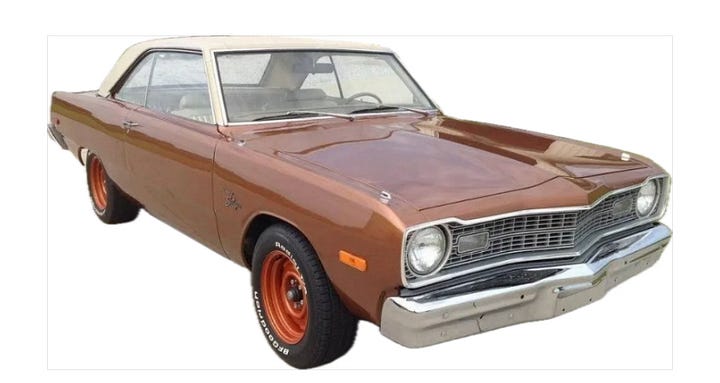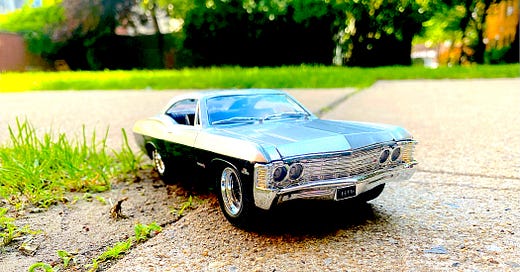It should come as no surprise that, in the sprawling urban universe of Mexico City, where streets and avenues are its lifeblood and automotive vehicles are the primary and most vital form of transportation, car culture should be a common subject in contemporary Mexican art, from Gabriel Orozco’s sliced, reduced and reassembled Citroen (La DS, 1993) to Damián Ortega’s deconstructed Beetle (Cosmic Thing, 2002), from Betsabeé Romero’s many installations and appropriations of car parts including etched mirrors and engraved tires to Rubén Ortiz-Torres’s lowriders.
However, I myself have to make the quasi-sacrilegious confession of having never been particularly interested in cars. Growing up, like most other boys, I did have my small share of miniature toy cars, but I was never so enticed by them to the extent of wanting to learn particular models or brands. It is perhaps a failure of my own sensibility to not have ever felt such a passion, and it perhaps could even be considered a betrayal of my very Chilango identity. Even when I lived in Chicago (another city that is challenging to live in without wheels), I primarily saw cars as tools to get from point A to point B. There I had my first (and so far, only) car, a burgundy 1988 Cutlass Ciera, purchased with my hard-earned money from my first museum, job from an ex-girlfriend’s uncle, a retired and obsessively neat refrigeration engineer who barely had ever used it and thus kept in perfect shape. My friends always cracked jokes when I would show up with it, as it was a car more appropriate for an 80-year-old immigrant pursuing the 1950s American dream than for the 26-year-old me.
But in spite of my lack of automobile expertise and curiosity, I nonetheless have come to appreciate how one develops sentimental relationships with them. There is a car repair shop near my house in Brooklyn, and whenever I walk past it, I experience a Mexico City version of Proust’s triggering madeleine —in this version, with the smell of motor oil. The smell reminds me of a car repair shop that we had in our street in Mexico City where we often brought our cars to fix, which in turn makes me think also of the long string of cars —mostly used— that we had throughout our family history.
Throughout the 1980s, my father really depended of a car to make deliveries of his kitchen and bathroom supplies to his clients across the city, which meant that he favored sturdy vehicles with large trunks, and drove all of them to the ground due to the heavy beating they all received and the daily cargo they all endured. He had a businessman friend by the name of Burak who over the years sold him quite a string of used cars (of various conditions) for that purpose.
There was, for example, the brown ’74 Dodge Dart, which we generally called “el café” (“the brown one”, which in Spanish is synonymous with “coffee”). This was a used car that my dad had purchased for primary use of my older brother, Nacho, when he started going to college. He would leave him notes in the morning telling him, “hijo, por favor ponle gasolina al café- pero no a tu taza” (“Son, please put gas on Coffee, but not to your cup”). El café was the car that we used when my dad taught me to drive. My dad would bring me at night to Naucalpan, a municipality in the State of Mexico, where he used to go for work and where there were huge industrial areas and vast, deserted parking lots, around an area with a number of mysterious street names (Calle Protón, Calle Átomo, Calle Neutrón, etc). I remember the amber street lights of those abandoned lots, and how during those years I was broken-hearted going through my internal, ridiculous teenage romantic sorrows while trying to learn how to park.
My brother’s habitual absentmindedness didn’t mix well with driving—a fact that became obvious the day he took the car to Tlalpan, near Cumbres del Ajusco National Park, one of the highest points on the outskirts of Mexico City. He and a friend, Santiago, were heading to a rustic cabin owned by Santiago’s family, nestled in the higher levels of the pine forest. The plan was presented to my parents as a camping trip—though I suspect the real intention was to party. The cabin offered a gorgeous view of the valley below, with a small village tucked right beneath it.
At some point that night, in a moment of careless confusion, my brother tried to back the car out and ended up reversing down a muddy slope. The vehicle slid through a ravine and came to a halt—precariously teetering on the edge of a cliff, with its rear wheels resting atop the roof of a small hut. The family of ranchers who lived in that house below rushed outside, stunned by the sight of a car dangling above them. Had it slipped just a bit more, it would have crashed through their roof. A dozen or so villagers came out to help. Together, they spent a good part of the night working to pull the car back to solid ground.


There was our 1977 green Maverick, a loyal and dependable car— one, however, that is attached with a sad memory for me. One day my dad and I went to pick up a cousin at the Mexico City airport; I was carrying a small orange Samsonite plastic briefcase that I used to emulate my dad’s attaché briefcase, and where I would put my favorite toys (including an Invisible man action figure). We left the car at a shady parking lot, and the car was stolen— with my briefcase inside. Miraculously, the police recovered the car, but my briefcase, along with my toys was gone forever. Everyone was so happy to recover the car that I felt no one properly acknowledged my loss. I still feel that I carry that unresolved theft with me.
While on the green side of the spectrum, another car that looms large in our family memory is our 1982 Volkswagen Beetle, the only car we ever purchased new during my childhood. The “Vocho” as is usually called in Mexico, is likely the car still most associated with the identity of Mexico City, even while its production stopped in 2003. Introduced in the 1950s, Beetles were enthusiastically embraced in Mexico due to being gas-efficient and durable. Our Volkswagen Beetle—an unfortunate shade of pea green (a color I’ve always loathed thanks to a lifelong aversion to green peas)—managed to survive nearly every upheaval in our family. In 1985, when my sisters went to study music at SMU in Dallas, my father decided they should take the car with them, so he drove them all the way from Mexico City, and I tagged along. That became my first international road trip, winding through Querétaro, Guanajuato, San Luis Potosí, Saltillo, and San Antonio, all the way up to Dallas.
We didn’t realize until we crossed the border that the car’s Mexican license plate was 854-ASS, a nomenclature to which no one had ever paid attention for years, but which took on a whole new meaning in the U.S.—much to our amusement and mild embarrassment. Later, my sister took the car to Chicago, where it continued to serve us during my college years. It bravely endured Chicago’s brutal winters and, lacking air conditioning, roasted us in its sweltering summers. Eventually, in the early ’90s, the car finally was sent to the junkyard—its doors barely working, the window’s rubber strip around its windows dangling, the seats broken, its springs protruding.
But perhaps the car that I often think the most about, as well as one that looms large in the pantheon of our family vehicles, is our 1970 gray Impala. It was the last grand car my father would manage to acquire before his business entered into trouble later that decade. With its vertical tail lights and imposing length (18 feet) and width (6 feet), this fifth-generation version was the top-selling model in the United States at the time. I was born the following year, so the life of this car aligned with the first years of mine; my very first car-related memories involve the Impala.
The Impala became the primary vehicle for deliveries; it being the size of a small boat it was able to withstand being packed with toilets, porcelain sinks, and boxes of tiles for about a decade. There was a moment, toward the end of its life, that one of its seats was broken so my father had to place one of the sink crates he used to carry in order to keep it upright. On the last days of the Impala, a series of unfortunate incidents included the engine catching fire and the driver’s wheel detaching from the car, leaving my father holding it in its hands like a lion trainer holding a hoop.
What I will remember the most of that car was the fact that as he drove me and my siblings to school, in the morning rush we would often have to bring our breakfast into the car to eat it, so plates with crumbs and empty glasses of chocolate milk were often left rolling around the car’s floor for extended periods of time.
I realize it may seem absurd to feel sentimental about a car. But drawing on Russell Belk’s Possessions and the Extended Self and Mihaly Csikszentmihalyi’s The Meaning of Things, both of which explore the emotional weight objects can carry, it becomes clear that cars are a powerful example of how material things can shape our identity and sense of independence. Existing somewhere between tool and dwelling, cars serve as vessels for our life experiences—repositories of memory and extensions of our private selves. They become familiar home bases as we navigate the world. This emotional attachment is echoed throughout literature, from E.B. White’s evocative story Farewell to Model T to Flannery O’Connor’s A Good Man is Hard to Find, both of which center on the emotional and symbolic roles cars can play in our lives.
Just as I didn’t care about car makes or models as a kid, I still don’t care about them now—least of all as status symbols or the prized possessions that make someone feel like a celebrity. What matters to me is the role cars play as companions in our journeys, and how those experiences are etched into them: in the scratches and dents, the stains and lingering smells—from dogs we once carried, to the mud tracked in on our shoes, to the faint scent of cigarettes still clinging to a side-door ashtray.
I now live in a city where a good pair of shoes matters more than owning a vehicle, and I don’t miss the stress of spending hours each week searching for parking. But unlike my old car, each subway ride feels impersonal—crowded with strangers and filled with mysterious smells. It’s harder to develop any sense of complicity or affection. Then again, now as then, the goal is simply to get from point A to point B. For the duration of a 20-minute ride, feelings are expendable.






